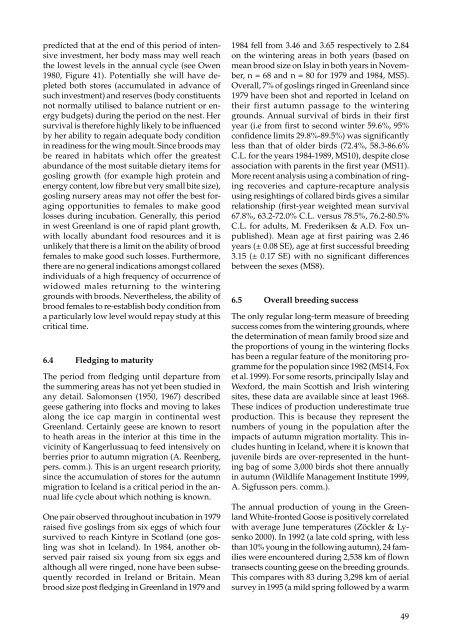The Greenland White-fronted Goose Anser albifrons flavirostris
The Greenland White-fronted Goose Anser albifrons flavirostris
The Greenland White-fronted Goose Anser albifrons flavirostris
Create successful ePaper yourself
Turn your PDF publications into a flip-book with our unique Google optimized e-Paper software.
predicted that at the end of this period of intensive<br />
investment, her body mass may well reach<br />
the lowest levels in the annual cycle (see Owen<br />
1980, Figure 41). Potentially she will have depleted<br />
both stores (accumulated in advance of<br />
such investment) and reserves (body constituents<br />
not normally utilised to balance nutrient or energy<br />
budgets) during the period on the nest. Her<br />
survival is therefore highly likely to be influenced<br />
by her ability to regain adequate body condition<br />
in readiness for the wing moult. Since broods may<br />
be reared in habitats which offer the greatest<br />
abundance of the most suitable dietary items for<br />
gosling growth (for example high protein and<br />
energy content, low fibre but very small bite size),<br />
gosling nursery areas may not offer the best foraging<br />
opportunities to females to make good<br />
losses during incubation. Generally, this period<br />
in west <strong>Greenland</strong> is one of rapid plant growth,<br />
with locally abundant food resources and it is<br />
unlikely that there is a limit on the ability of brood<br />
females to make good such losses. Furthermore,<br />
there are no general indications amongst collared<br />
individuals of a high frequency of occurrence of<br />
widowed males returning to the wintering<br />
grounds with broods. Nevertheless, the ability of<br />
brood females to re-establish body condition from<br />
a particularly low level would repay study at this<br />
critical time.<br />
6.4 Fledging to maturity<br />
<strong>The</strong> period from fledging until departure from<br />
the summering areas has not yet been studied in<br />
any detail. Salomonsen (1950, 1967) described<br />
geese gathering into flocks and moving to lakes<br />
along the ice cap margin in continental west<br />
<strong>Greenland</strong>. Certainly geese are known to resort<br />
to heath areas in the interior at this time in the<br />
vicinity of Kangerlussuaq to feed intensively on<br />
berries prior to autumn migration (A. Reenberg,<br />
pers. comm.). This is an urgent research priority,<br />
since the accumulation of stores for the autumn<br />
migration to Iceland is a critical period in the annual<br />
life cycle about which nothing is known.<br />
One pair observed throughout incubation in 1979<br />
raised five goslings from six eggs of which four<br />
survived to reach Kintyre in Scotland (one gosling<br />
was shot in Iceland). In 1984, another observed<br />
pair raised six young from six eggs and<br />
although all were ringed, none have been subsequently<br />
recorded in Ireland or Britain. Mean<br />
brood size post fledging in <strong>Greenland</strong> in 1979 and<br />
1984 fell from 3.46 and 3.65 respectively to 2.84<br />
on the wintering areas in both years (based on<br />
mean brood size on Islay in both years in November,<br />
n = 68 and n = 80 for 1979 and 1984, MS5).<br />
Overall, 7% of goslings ringed in <strong>Greenland</strong> since<br />
1979 have been shot and reported in Iceland on<br />
their first autumn passage to the wintering<br />
grounds. Annual survival of birds in their first<br />
year (i.e from first to second winter 59.6%, 95%<br />
confidence limits 29.8%-89.5%) was significantly<br />
less than that of older birds (72.4%, 58.3-86.6%<br />
C.L. for the years 1984-1989, MS10), despite close<br />
association with parents in the first year (MS11).<br />
More recent analysis using a combination of ringing<br />
recoveries and capture-recapture analysis<br />
using resightings of collared birds gives a similar<br />
relationship (first-year weighted mean survival<br />
67.8%, 63.2-72.0% C.L. versus 78.5%, 76.2-80.5%<br />
C.L. for adults, M. Frederiksen & A.D. Fox unpublished).<br />
Mean age at first pairing was 2.46<br />
years (± 0.08 SE), age at first successful breeding<br />
3.15 (± 0.17 SE) with no significant differences<br />
between the sexes (MS8).<br />
6.5 Overall breeding success<br />
<strong>The</strong> only regular long-term measure of breeding<br />
success comes from the wintering grounds, where<br />
the determination of mean family brood size and<br />
the proportions of young in the wintering flocks<br />
has been a regular feature of the monitoring programme<br />
for the population since 1982 (MS14, Fox<br />
et al. 1999). For some resorts, principally Islay and<br />
Wexford, the main Scottish and Irish wintering<br />
sites, these data are available since at least 1968.<br />
<strong>The</strong>se indices of production underestimate true<br />
production. This is because they represent the<br />
numbers of young in the population after the<br />
impacts of autumn migration mortality. This includes<br />
hunting in Iceland, where it is known that<br />
juvenile birds are over-represented in the hunting<br />
bag of some 3,000 birds shot there annually<br />
in autumn (Wildlife Management Institute 1999,<br />
A. Sigfusson pers. comm.).<br />
<strong>The</strong> annual production of young in the <strong>Greenland</strong><br />
<strong>White</strong>-<strong>fronted</strong> <strong>Goose</strong> is positively correlated<br />
with average June temperatures (Zöckler & Lysenko<br />
2000). In 1992 (a late cold spring, with less<br />
than 10% young in the following autumn), 24 families<br />
were encountered during 2,538 km of flown<br />
transects counting geese on the breeding grounds.<br />
This compares with 83 during 3,298 km of aerial<br />
survey in 1995 (a mild spring followed by a warm<br />
49


